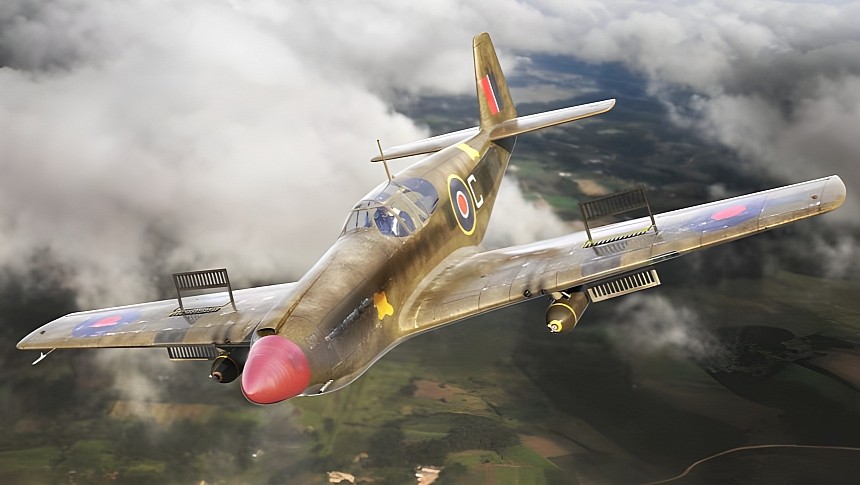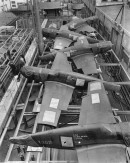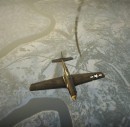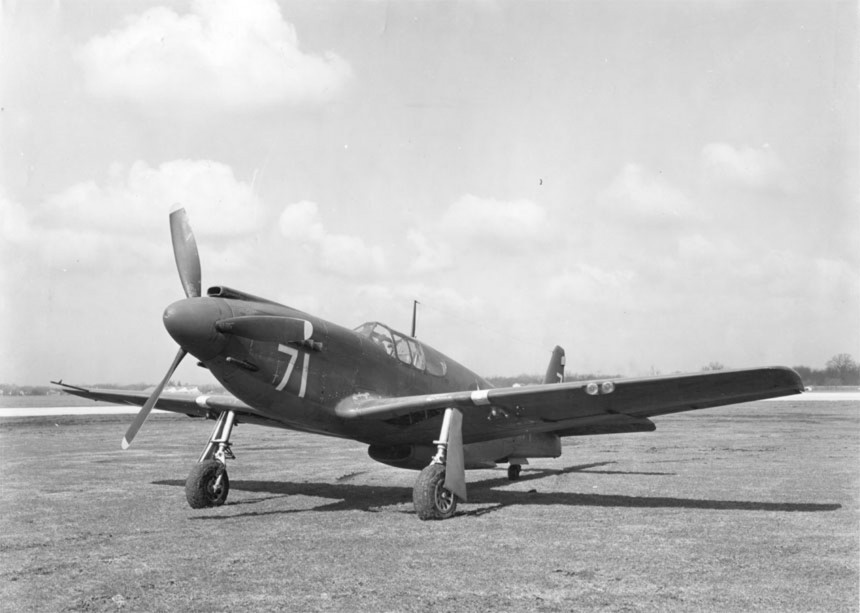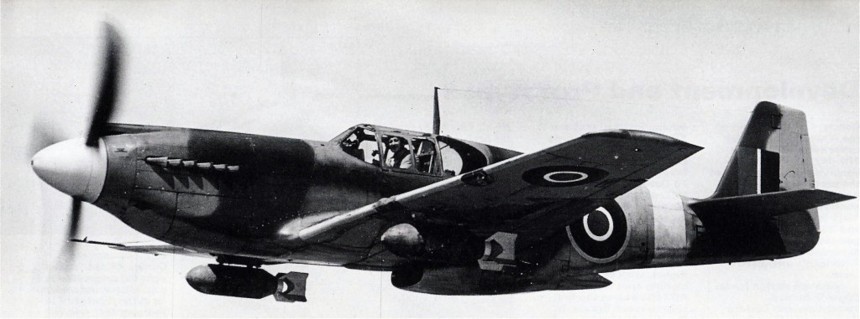If the North American P-51 Mustang were a sportsman, it'd be Lionel Messi or Lebron James. If it were a movie, it'd be Pulp Fiction or James Cameron's Titanic. The point is that the Mustang is the most well-remembered and well-celebrated American fighter of World War II, bar none, end of story. But that doesn't mean every aspect of its war service is held on a pedestal like the most sacred of sacred cows. There's always something obscure yet exciting to uncover if you look hard enough.
For instance, did you know the greatest piston-engine dogfighter the U.S. ever built had a little-remembered ground-attack relative? That's right. In a sea of Thunderbolts and Flying Fortresses giving Axis ground targets all the hell they could handle, a specially modified P-51 airframe joined in on the fun for a time. This is the story of the A-36 "Apache," the P-51 Mustang's forgotten family member with a penchant for dive bombing. To uncover the full tale of the A-36, we need to go back to 1942.
It was in this year that the British Royal Air Force received its first shipment of P-51s, then known as the NA-73 and then as the XP-51, as a supplement to existing squadrons of Curtiss P-40C Tomahawk fighters already in service with the RAF via the Lend-Lease program. Dubbed the North American Mustang Mk.I in British service, and the Mk.IA, when fitted with quad Hispano 200 mm cannons for armament, these all-American war machines from Inglewood, California, didn't take long to get on the good side of British pilots. Indeed, it was a British pilot flying a Royal Canadian Air Force Mk.I Mustang that shot down the plane's first enemy fighter, a German Fw-190A, over Dieppe, France, during Operation Jubilee in August 1942.
At low-to-medium altitudes, British Mustang pilots found its performance to be on par with their own domestic single-engine fighters like the Spitfire and the Hurricane. But early examples of the Mustang sporting Allison V-1710 piston engines were seen as not up to the same standards as Spitfires sporting Rolls-Royce Merlin V12s at higher altitudes where German fighters hunting for bombers often flew. Even so, it wasn't hard for the RAF to take to the American Mustang like ducks to water. But as hard as it is to believe nowadays, this alone wasn't enough to keep the Mustang in production after the first RAF order for 650 Mustang Mk.Is and Mustang Mk.IIs.
By the time Japan attacked the U.S. Navy installation at Pearl Harbor in December 1941, the U.S. Army Air Corps, not yet in a state of total war, was a bit strapped for cash in defense spending. Large albatross contracts and considerable back-orders for Lockheed P-38s, Bell P-39s, and the then brand-new Republic P-47 left very little room for the production and upkeep of any other American fighter. In the days before the Mustang was universally praised as the Cadillac of the sky, the P-51 were the odd one out among the group.
But there were those in the Army Air Corps who saw limitless potential in the Mustang's airframe. People who believed that one day, the P-51 could be held in the same breath as the Spitfire as the greatest Allied single-engine fighter of the entire war; This man was Major General Oliver P. Echols. As the man most instrumental in facilitating the P-51's sale to the British under Lend-Lease, Major General Echols knew with the right modifications, the Mustang had a place in the skies over Europe and the Pacific.
In a last-ditch effort to keep the Mustang platform in production, North American Aviation's chief designer James H. "Dutch" Kindelberger, worked closely with Echols to take the Mustang's design in a different direction. As 1942 got underway, the two men worked tirelessly to modify the existing Mustang fighter airframe into a dive bomber. If the standard P-51 was the Allied answer to the Bf-109 and the Fw-190, then its dive bomber cousin was a similar match for German dive bombers like the Ju-87 Stuka. By keeping the early P-51's airframe intact, redesigning the wings to be sturdier in high-g dive-bombing maneuvers, and adding hydraulic dive flaps to the tops and bottoms of both wings, this new ground-pounding Mustang covered all the bases of a good dive bomber.
With the blueprints complete, Kindelberger and Echols presented their findings to the one man who could realistically sway the Army Air Corps' perception of the Mustang, U.S. Army General Henry H. Arnold. Safe to say, the man whose friends called him "Hap" liked what he saw. As in, he really liked what he saw. To the point where he recommended further modifications like replacing the plane's Hispano cannons will a full suite of M2 Browing .50-caliber machine guns. With General Arnold's blessing now secured, the P-51 Mustang's factory in Inglewood finally had the second wind it was looking for.
Now officially dubbed the A-36 Apache, though it was hardly ever referred to by this name in the field, the first example took to the skies over Southern California on September 21st, 1942. In trial flights, North American Aviation test pilots found the A-36 to be spectacularly fast in a dive, as quick as 450 to 500 mph (724 to 804 kph) in a dive, and that the wing-mounted dive flaps could only slow the plane down to a brisk 350 mph (577.7 kph). The speed was so intense that one early A-36 airframe crashed when the pilot misinterpreted their airspeed and altitude in relation to the ground. After this event, all A-36 crews were limited to a diving angle of 70 degrees during combat sorties.
Upon its official Army Air Corps deployment in late 1942, the A-36 joined up with the Douglas A-20 Havoc twin-engine attack planes of the 27th Fighter-Bomber Group in French Morocco. It was just in time for the ongoing Allied campaign in North Africa, flanked by British, Canadian, Australian, and Indian units, among others, against Germany and Fascist Italy. Admittedly, rumors of problems with the A-36's dive flaps made their way around its squadrons in the early days. It's even been said that some pilots even wired their dive flaps permanently shut, although much of this appears to be conjecture.
As the Allies advanced through North Africa and into Italy, squadrons of A-36s followed suit. Ditto for American activity in the China-Burma theater as well as in India after being transferred there via Australia. Wherever the Apache flew, pilots lauded the plane for its considerable dive bombing prowess but also its ability to handle itself in a dogfight. In fact, one Apache pilot, Lieutenant Michael T. Russo, even managed to shoot down five enemy planes, becoming the only Allison-engined Mustang pilot to earn the title of ace. In one capacity or another, the A-36 remained in service with the Army Air Corps until the end of World War II and was retired upon its conclusion.
By this time, the Mustang's airframe had long been retrofitted with license-built copies of Rolls-Royce Merlin engines in its B, C, and D variants. This led to the Apache and, indeed, most early Allison-engined Mustangs taking a backseat in the story of World War II's most iconic American fighter. Today, only two airworthy A-36s survive in private collections while another, airframe 42-83665, sits on display at the National Museum of the United States Air Force in Dayton, Ohio.
Meanwhile, a whole new generation of av-geeks was introduced to the ground-pound Mustang on June 30th, 2015, with the Apache's addition in the update 1.41 "Cold Steel" for Gaijin Entertainment's vehicle combat simulator War Thunder. With an air realistic-battle rating of 3.0, the A-36 found itself the favorite of many novice War Thunder aviators who no doubt found the novelty of a dive bomber built from a fighter plane just as amusing as its pilots did so many decades ago.
It was in this year that the British Royal Air Force received its first shipment of P-51s, then known as the NA-73 and then as the XP-51, as a supplement to existing squadrons of Curtiss P-40C Tomahawk fighters already in service with the RAF via the Lend-Lease program. Dubbed the North American Mustang Mk.I in British service, and the Mk.IA, when fitted with quad Hispano 200 mm cannons for armament, these all-American war machines from Inglewood, California, didn't take long to get on the good side of British pilots. Indeed, it was a British pilot flying a Royal Canadian Air Force Mk.I Mustang that shot down the plane's first enemy fighter, a German Fw-190A, over Dieppe, France, during Operation Jubilee in August 1942.
At low-to-medium altitudes, British Mustang pilots found its performance to be on par with their own domestic single-engine fighters like the Spitfire and the Hurricane. But early examples of the Mustang sporting Allison V-1710 piston engines were seen as not up to the same standards as Spitfires sporting Rolls-Royce Merlin V12s at higher altitudes where German fighters hunting for bombers often flew. Even so, it wasn't hard for the RAF to take to the American Mustang like ducks to water. But as hard as it is to believe nowadays, this alone wasn't enough to keep the Mustang in production after the first RAF order for 650 Mustang Mk.Is and Mustang Mk.IIs.
By the time Japan attacked the U.S. Navy installation at Pearl Harbor in December 1941, the U.S. Army Air Corps, not yet in a state of total war, was a bit strapped for cash in defense spending. Large albatross contracts and considerable back-orders for Lockheed P-38s, Bell P-39s, and the then brand-new Republic P-47 left very little room for the production and upkeep of any other American fighter. In the days before the Mustang was universally praised as the Cadillac of the sky, the P-51 were the odd one out among the group.
In a last-ditch effort to keep the Mustang platform in production, North American Aviation's chief designer James H. "Dutch" Kindelberger, worked closely with Echols to take the Mustang's design in a different direction. As 1942 got underway, the two men worked tirelessly to modify the existing Mustang fighter airframe into a dive bomber. If the standard P-51 was the Allied answer to the Bf-109 and the Fw-190, then its dive bomber cousin was a similar match for German dive bombers like the Ju-87 Stuka. By keeping the early P-51's airframe intact, redesigning the wings to be sturdier in high-g dive-bombing maneuvers, and adding hydraulic dive flaps to the tops and bottoms of both wings, this new ground-pounding Mustang covered all the bases of a good dive bomber.
With the blueprints complete, Kindelberger and Echols presented their findings to the one man who could realistically sway the Army Air Corps' perception of the Mustang, U.S. Army General Henry H. Arnold. Safe to say, the man whose friends called him "Hap" liked what he saw. As in, he really liked what he saw. To the point where he recommended further modifications like replacing the plane's Hispano cannons will a full suite of M2 Browing .50-caliber machine guns. With General Arnold's blessing now secured, the P-51 Mustang's factory in Inglewood finally had the second wind it was looking for.
Now officially dubbed the A-36 Apache, though it was hardly ever referred to by this name in the field, the first example took to the skies over Southern California on September 21st, 1942. In trial flights, North American Aviation test pilots found the A-36 to be spectacularly fast in a dive, as quick as 450 to 500 mph (724 to 804 kph) in a dive, and that the wing-mounted dive flaps could only slow the plane down to a brisk 350 mph (577.7 kph). The speed was so intense that one early A-36 airframe crashed when the pilot misinterpreted their airspeed and altitude in relation to the ground. After this event, all A-36 crews were limited to a diving angle of 70 degrees during combat sorties.
As the Allies advanced through North Africa and into Italy, squadrons of A-36s followed suit. Ditto for American activity in the China-Burma theater as well as in India after being transferred there via Australia. Wherever the Apache flew, pilots lauded the plane for its considerable dive bombing prowess but also its ability to handle itself in a dogfight. In fact, one Apache pilot, Lieutenant Michael T. Russo, even managed to shoot down five enemy planes, becoming the only Allison-engined Mustang pilot to earn the title of ace. In one capacity or another, the A-36 remained in service with the Army Air Corps until the end of World War II and was retired upon its conclusion.
By this time, the Mustang's airframe had long been retrofitted with license-built copies of Rolls-Royce Merlin engines in its B, C, and D variants. This led to the Apache and, indeed, most early Allison-engined Mustangs taking a backseat in the story of World War II's most iconic American fighter. Today, only two airworthy A-36s survive in private collections while another, airframe 42-83665, sits on display at the National Museum of the United States Air Force in Dayton, Ohio.
Meanwhile, a whole new generation of av-geeks was introduced to the ground-pound Mustang on June 30th, 2015, with the Apache's addition in the update 1.41 "Cold Steel" for Gaijin Entertainment's vehicle combat simulator War Thunder. With an air realistic-battle rating of 3.0, the A-36 found itself the favorite of many novice War Thunder aviators who no doubt found the novelty of a dive bomber built from a fighter plane just as amusing as its pilots did so many decades ago.
